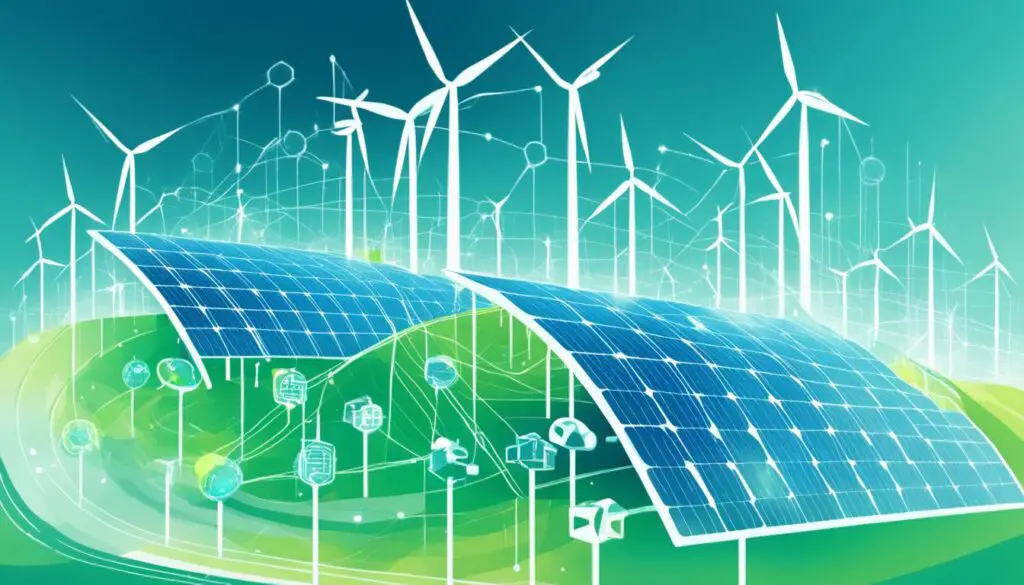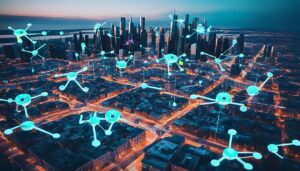
As the demand for clean and sustainable energy sources continues to grow, the integration of artificial intelligence (AI) in renewable energy forecasting has become a game-changer. With advanced algorithms and machine learning techniques, AI systems have the power to accurately predict the availability and output of wind and solar power, revolutionizing the way we harness renewable energy.
Renewable energy, such as wind and solar power, has the potential to transform our energy landscape. However, the challenge lies in accurately forecasting the availability and output of these sources, which can vary depending on weather conditions and other factors. This is where AI steps in, utilizing vast amounts of data and sophisticated models to provide precise predictions.
By analyzing data from weather stations, satellite imagery, and historical energy production, AI algorithms can generate forecasts that help energy providers optimize their operations. These forecasts enable efficient resource allocation, reduce costs, and improve the overall stability of the energy grid.
The benefits of AI in renewable energy forecasting are vast. It not only increases efficiency in utilizing renewable energy sources but also contributes to optimized energy production and distribution mechanisms. Furthermore, AI systems can identify potential issues in the infrastructure, allowing for timely maintenance and repairs, thus enhancing overall system reliability.
With AI leading the way, the future of renewable energy looks bright. By leveraging AI technology, we can unlock the full potential of wind and solar power, paving the way for a clean and sustainable energy future.
Key Takeaways:
- AI plays a crucial role in accurately predicting the availability and output of renewable energy sources.
- The integration of AI in renewable energy forecasting leads to increased efficiency and optimized energy production.
- AI helps reduce costs and improve the stability of the energy grid.
- Timely maintenance and repairs can be facilitated by AI systems, ensuring the reliability of renewable energy infrastructure.
- AI holds the potential to unlock a clean and sustainable energy future.
The Role of AI in Renewable Energy Forecasting
AI technology plays a crucial role in the field of renewable energy forecasting. By utilizing advanced algorithms and machine learning techniques, AI systems can effectively analyze massive amounts of data collected from various sources, including weather stations, satellite imagery, and historical energy production data. Through the application of predictive models and data analysis, AI algorithms generate accurate forecasts for the availability and output of renewable energy sources.
One of the key advantages of AI technology in renewable energy forecasting is its ability to continuously learn and optimize its forecasting accuracy over time. As more data is collected and analyzed, AI systems adapt and improve their predictions, assisting energy providers in making informed decisions and optimizing their operations.
The integration of AI in renewable energy forecasting enhances the efficiency and reliability of energy production using renewable sources. By leveraging AI technology, energy providers can better plan and manage their operations, ensuring the optimal utilization of renewable energy sources.
AI technology plays a crucial role in renewable energy forecasting. By utilizing advanced algorithms and machine learning techniques, AI systems can effectively analyze massive amounts of data collected from various sources, including weather stations, satellite imagery, and historical energy production data.
This not only leads to increased energy production efficiency but also helps in reducing costs and improving grid stability. Through accurate predictions, energy providers can optimize their energy distribution mechanisms and reduce wastage, resulting in cost savings. Additionally, AI systems can help identify potential issues or faults in the renewable energy infrastructure, enabling timely maintenance and repairs to enhance overall system efficiency and reliability.
The partnership between AI technology and renewable energy sources is instrumental in the pursuit of a clean and sustainable future. By harnessing the power of AI in forecasting renewable energy availability and output, we can maximize the potential of renewable energy sources, paving the way for a greener and more sustainable power generation landscape.

Benefits of AI in Renewable Energy Forecasting
The integration of AI in renewable energy forecasting brings numerous benefits, revolutionizing the way we harness wind and solar power for a sustainable future. By leveraging advanced algorithms and machine learning techniques, AI systems offer increased efficiency, optimized energy production, reduced costs, and improved grid stability.
Increased Efficiency in Utilizing Renewable Energy Sources
AI plays a vital role in optimizing the utilization of renewable energy sources. With accurate predictions of wind and solar power availability and output, energy providers can optimize their energy production and distribution mechanisms. By maximizing the use of renewable energy sources, overall efficiency is significantly increased.
Optimized Energy Production and Reduced Costs
AI-generated forecasts enable energy providers to better plan and manage their operations. By understanding the expected availability and output of renewable energy sources, providers can align their production schedules, reducing unnecessary wastage and optimizing energy production. This optimization leads to cost reductions, making renewable energy more economically viable.
Improved Grid Stability with Timely Maintenance and Repairs
AI systems can identify potential issues or faults in the renewable energy infrastructure. By detecting anomalies early on, energy providers can schedule timely inspections, maintenance, and repairs to ensure the smooth functioning of the system. This proactive approach improves overall grid stability, minimizing disruptions and maximizing energy delivery.
| Benefits | Description |
|---|---|
| Increased Efficiency | AI optimizes the utilization of renewable energy sources, maximizing efficiency. |
| Optimized Energy Production | AI-generated forecasts help providers align production schedules, reducing wastage. |
| Reduced Costs | Efficient energy production and management result in cost reductions. |
| Improved Grid Stability | Timely maintenance and repairs based on AI system insights enhance grid stability. |
Overall, the integration of AI in renewable energy forecasting offers significant advantages. By harnessing its full potential, we can pave the way for a cleaner and more sustainable future.

Conclusion
The integration of AI in renewable energy forecasting is revolutionizing the way we harness renewable energy sources for a clean and sustainable future. Through the use of advanced algorithms and machine learning techniques, AI systems are able to accurately predict the availability and output of wind and solar power, enabling increased efficiency, optimized energy production, and reduced costs.
By leveraging the power of AI, energy providers can make informed decisions based on accurate forecasts, ensuring renewable energy sources are utilized to their full potential. This not only reduces our reliance on fossil fuels but also contributes to a cleaner and greener environment. The integration of AI in renewable energy forecasting also leads to improved grid stability, enabling a more reliable and resilient energy system.
With the continuous advancements in AI technology, the renewable energy sector is on the path to achieving even greater levels of clean and sustainable power generation. As AI systems continue to learn and optimize their forecasting models, the future of renewable energy looks bright. By harnessing the potential of AI, we can create a cleaner, more sustainable energy future for generations to come.
FAQ
How does AI technology contribute to renewable energy forecasting?
AI technology contributes to renewable energy forecasting by utilizing massive amounts of data from various sources, such as weather stations, satellite imagery, and historical energy production data. Using predictive models and advanced data analysis techniques, AI algorithms can analyze this data and generate accurate forecasts for the availability and output of renewable energy sources.
What are the benefits of integrating AI in renewable energy forecasting?
The integration of AI in renewable energy forecasting brings several benefits, including increased efficiency in the utilization of renewable energy sources. By accurately predicting the availability and output of wind and solar power, energy providers can optimize their production and distribution mechanisms, leading to reduced costs and improved grid stability. AI systems can also help identify potential issues in the renewable energy infrastructure, enabling timely maintenance and repairs.
How does AI improve the efficiency of renewable energy production?
AI improves the efficiency of renewable energy production by accurately predicting the availability and output of wind and solar power. With these accurate forecasts, energy providers can optimize their operations, ensuring that renewable energy sources are used to their full potential. This leads to increased efficiency, reduced costs, and improved grid stability.
Can AI help with identifying and repairing issues in renewable energy infrastructure?
Yes, AI can help with identifying and repairing issues in renewable energy infrastructure. By analyzing data and monitoring the performance of renewable energy systems, AI systems can detect potential issues or faults. This enables energy providers to take timely maintenance and repair actions, improving the overall efficiency and reliability of the system.
How does AI technology contribute to a clean and sustainable future?
AI technology contributes to a clean and sustainable future by revolutionizing the way we harness renewable energy sources. With advanced algorithms and machine learning techniques, AI systems accurately predict the availability and output of wind and solar power. This leads to increased efficiency, optimized energy production, and reduced costs, paving the way for a cleaner and more sustainable power generation.
Source Links
- https://www.mdpi.com/1422-0067/25/5/2900
- https://www.mdpi.com/2071-1050/16/5/2065
- https://www.mdpi.com/2079-9292/13/5/960








